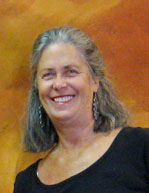About Me
This artist Remington creates raw-edged abstracts
Maggie Remington’s “Earth Paintings” can stop you in your tracks.
© Silver Stanfill THE RIDGWAY SUN
 These raw-edged canvases are 15 to 30 square feet of textured abstraction in southwestern landscape colors, swoops and daubs of local gold, green, blue, orange and brown. Her pictures have literal geographic names: Flagstaff, Grand Mesa, Government Springs. But they are landscapes only in an unusual sense of the word. For Remington, land is the easel, palette and pigment rather than a visual subject. The physical content of her pictures really is earth, dug from (or near) the place furnishing a picture’s title. After getting to know an area, she lays unprimed, unstretched canvas out on the ground to receive gluey swatches of mud, sand and crushed rock that she mixes and applies by hand or with weeds or branches.Another unusual characteristic of her work is that one canvas can suggest, simultaneously, huge things seen from huge distances or small things much magnified. Remington earth paintings celebrate patterns of nature: river beds or mountain ranges seen from ten miles up, a canyon’s geology, anatomy of a trout jaw, an amoeba extending a pseudopod, DNA structure. But rather than aiming for recognition, Remington’s work provokes reflection. Instead of showing what any sojourner could see, her paintings invite viewers to experience a response to a place. Think of Rothko (spiritual majesty) meets O’Keefe (commitment to locality). “In the particular lies the universal,” wrote the poet William Carlos Williams. Maggie Remington paints universals out of particulars.
These raw-edged canvases are 15 to 30 square feet of textured abstraction in southwestern landscape colors, swoops and daubs of local gold, green, blue, orange and brown. Her pictures have literal geographic names: Flagstaff, Grand Mesa, Government Springs. But they are landscapes only in an unusual sense of the word. For Remington, land is the easel, palette and pigment rather than a visual subject. The physical content of her pictures really is earth, dug from (or near) the place furnishing a picture’s title. After getting to know an area, she lays unprimed, unstretched canvas out on the ground to receive gluey swatches of mud, sand and crushed rock that she mixes and applies by hand or with weeds or branches.Another unusual characteristic of her work is that one canvas can suggest, simultaneously, huge things seen from huge distances or small things much magnified. Remington earth paintings celebrate patterns of nature: river beds or mountain ranges seen from ten miles up, a canyon’s geology, anatomy of a trout jaw, an amoeba extending a pseudopod, DNA structure. But rather than aiming for recognition, Remington’s work provokes reflection. Instead of showing what any sojourner could see, her paintings invite viewers to experience a response to a place. Think of Rothko (spiritual majesty) meets O’Keefe (commitment to locality). “In the particular lies the universal,” wrote the poet William Carlos Williams. Maggie Remington paints universals out of particulars.
The logistics are daunting: first, a portable studio, adaptable for sustained travel and camping where climate, geology and topography permit long hours of sweaty activity in the open air and access to usable soils. When Remington paints in National Forests, she hauls in earth colors from well beyond forest boundaries. Besides bulky rolls of raw canvas, she has to stow tools for digging, crunching and mixing — and store new work which, till cured, may need extra space. Her finished pieces have the consistency of tanned hides. She stacks and rolls them together in bundles two or three times as heavy as what she started with.
Even more daunting is the discipline of six months a year alone on the road, hiking, messing around with dirt and spending hours bent over a bedspread-sized piece of cloth on the ground. Yet this is a woman who never had an art class in school or college, whose formal education and first career were in business and executive level finance,– and who only two years ago cleared her decks for art by selling everything except family heirlooms she could talk people into keeping.
What got her into this? An unusual childhood, awareness that she would “always end up in beautiful places,” and post-divorce dreams. Maggie grew up as a “general Motors kid” in Sao Paulo, Brazil; went to high school in Hanover, New Hampshire, (a “good place for a divorced woman [her mother] to raise five kids; before she earned a business degree at a small Catholic women’s college near Washington DC. As soon as she could, she was off to work in San Francisco. Then came marriage, a child, increasingly responsible jobs, and moves to Arizona and back to California. Her own divorce, she says, “opened up me to me.”
Involved in this opening up were travel (around the world, all national parks in western USA) and dreams of using only her hands and earth to make mammoth murals. Spiritual searching, including intense study of Native American cultures, led to a fascination with Indian sand painting. And then–about time!–a non-credit evening beginning watercolor class. (“As close as I could get to finger painting for grownups.”) Other adult ed art courses and some fine coincidences later, she had a mentor, an emotional homeplace, and a compulsion to start a new life. A German artist whose works resembled Maggie’s earlier dreams helped stabilize her earth-paint-making technology; a managerial mortgage banking position brought Maggie to Telluride. By the spring of 1998, Maggie says, “the urge to work with earth was driving me nuts,” and she began preparing for her first odyssey.
In six months she drove over eleven thousand miles from Colorado through Mexico, stopping many places to reflect and paint–where friends lived, beside the road, in towns, along freeways. Getting good dirt (“earth is everywhere”) or permission to work on what looked like private property seemed to happen naturally. She’d knock on a door, and found “most people very interested and cooperative.” Probably none of these helpful people knew they were dealing with and up-and-coming Remington barely begun on what’s bound to be an important body of work. Yes: through her paternal grandmother, Maggie is a descendant twice related to famed western sculptor Frederick Remington.
Late in July 2000, Maggie returned to her Ridgeway home base barely in time to apply for a space in that town’s prestigious Arts and Crafts Rendezvous. With a borrowed tent and six of her earliest earth paintings–in her first ever exhibit–she won one of the show’s six prizes, for “most unusual entry.” More of her work now hangs in a gallery near Santa Barbara, and she has been invited to join the Women’s Environmental Art Association.




